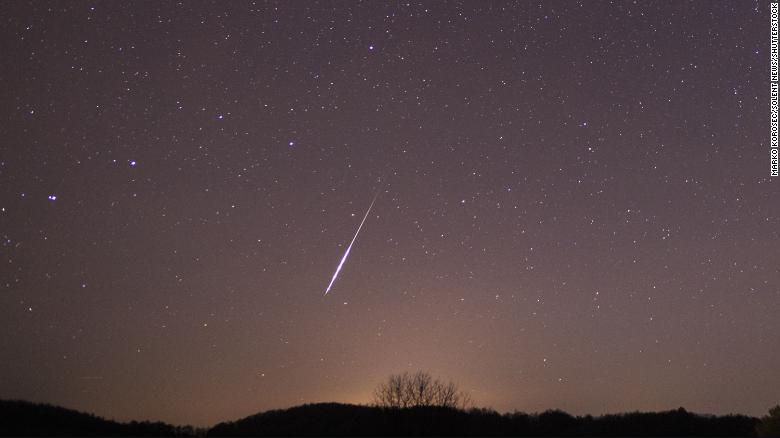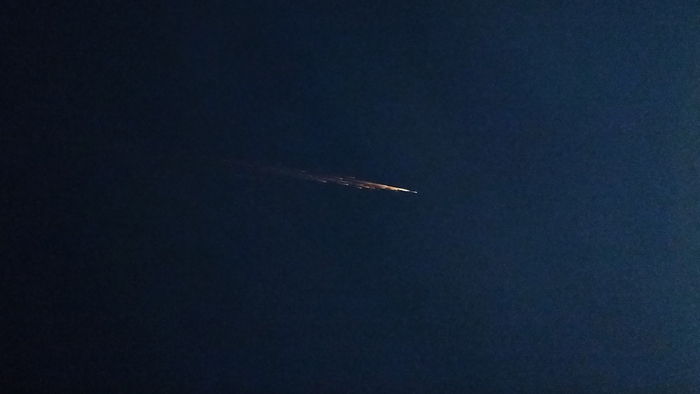If you could not see the Perseids, here we show them 0:33
(CNN) -
A light show will shine Thursday night as the Southern Taurid meteor shower shoots across the sky.
The meteor shower peaks in the late hours of November 4 until dawn on November 5, according to EarthSky.
The exact peak of the rain is 1 a.m. ET, or 5 a.m. GMT, EarthSky said.
Taurids are sometimes known for their fireballs, or meteorites, that often exceed 3.3 feet (1 meter) across and are exceptionally bright, according to NASA.
A meteor streaks through the sky during the 2015 Taurid meteor shower.
Southern taurids originate from Comet 2P / Encke, according to EarthSky, and viewers can expect to see around five meteors per hour.
Meteors will be visible in almost every part of the world except the southern polar regions due to their long hours of daylight at this time of year, said Robert Lunsford, a consultant to the American Meteor Society.
Viewers won't have to worry about moonlight obstructing their view because there's a new moon on Thursday night, according to the Old Farmer's Almanac.
advertising
Throughout the lunar cycle, the sun illuminates part of the moon.
When there is a new moon, half of the sun shines in the opposite direction to Earth, which means that the sky will be darker than usual, according to NASA.
How to watch the meteor shower
EarthSky shared some tips on how to view the meteor shower.
For the best viewing conditions, go to an area with little or no artificial light where a large area of the sky is visible.
Patience is key when it comes to spotting meteor showers, so grab a chair and blanket and make yourself comfortable.
There are more meteor showers for the remainder of 2021, according to the EarthSky 2021 meteor shower guide:
November 11-12: Northern Taurids
November 17: Leonidas
December 13-14: Geminids
December 22: Ursidas
Eclipses
This year, there will be one more solar eclipse and another lunar eclipse, according to The Old Farmer's Almanac.
A partial lunar eclipse will take place on November 19, and sky watchers in North America and Hawaii will be able to see it between 1 a.m. ET and 7:06 a.m. ET.
The last month of the year will begin with a total solar eclipse on December 4.
It will not be visible in North America, but it will be visible in the Falkland Islands, the southern tip of Africa, Antarctica and southeastern Australia.
Visible planets
Sky watchers will have multiple opportunities to spot planets in our sky on certain mornings and nights throughout 2021, according to the Farmer's Almanac planetary guide.
It is possible to see most of these with the naked eye, with the exception of Neptune, but binoculars or a telescope will help a better view.
Mercury will shine in the night sky from November 29 to December 31.
Venus, our closest neighbor in the solar system, will appear in the western sky at dusk at night until December 31.
It is the second brightest object in our sky, after the moon.
Mars will show its reddish appearance in the morning sky between November 24 and December 31.
Jupiter, the largest planet in our solar system, is, when visible, the third brightest object in our sky.
Look for him in the evenings until December 31.
Saturn's rings are only visible through a telescope, but the planet itself can still be seen with the naked eye in the evenings from now until December 31.
Binoculars or a telescope will help you locate the greenish glow of Uranus on the nights of November 4 to December 31.
It will be brighter until December 31st.
And our most distant neighbor in the solar system, Neptune, will be visible through a telescope during the nights until December 31.
It will be brighter until November 8.
meteor shower




